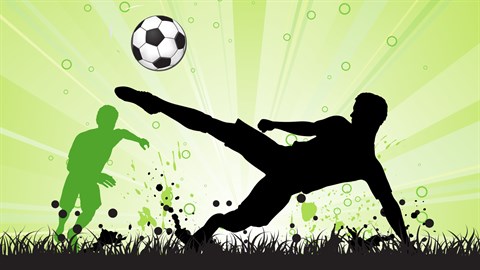10 BASIC SOCCER EXERCISES FOR BEGINNERS
If you're passionate about soccer and aspire to take on various positions on the field, start by honing your skills with professional soccer exercises to elevate your game! In this article, Sport9 shares 10 football prediction match exercises for beginners.
Dribbling Exercises
Basic soccer exercises for kids start with dribbling drills, helping them get acquainted with ball control. Although it sounds simple, this exercise requires agility and finesse from the practitioner. It's also one of the indispensable skills and quite challenging to master.
By placing 5-10 cones in a straight line about 1.5m apart, we need to dribble the ball quickly through the cones without letting the ball leave our feet. Continuously move the ball forward, weaving through the right side of the first cone and then the left side of the next cone, and so on until all cones are completed. Repeat the process.
Dribbling exercises are the first basic exercise.
Passing Exercises
Passing the ball is one of the essential skills in basic soccer training. Ensuring ball control and delivering passes to teammates to facilitate moving the ball towards the opponent's goal, thus creating scoring opportunities.
This is considered a vital exercise, requiring cleverness and intelligence in ball control. If you're a new player, dedicate more time to practicing this skill, as it will enhance your ability to make accurate passes or precise through balls, creating significant goal-scoring opportunities for your team.
Passing exercises are essential in basic soccer training.
Shooting Exercises
Shooting is an exciting exercise because everyone wants to score for their team by shooting the ball into the desired position. However, this skill is quite challenging and requires hours, even days of practice for effectiveness, leading to decisive and accurate shots.
First, perform 20 shots—10 shots with the right foot and 10 shots with the left foot continuously. Then practice shooting at different positions in the goal, starting from each corner and then changing angles flexibly. Alternate between shooting with the right and left feet to improve shooting ability with both.
Learn more skills you need to know in soccer such as football tips for sunday
Offensive Exercises
You can't practice soccer alone with offensive exercises because this requires a minimum of 2 players and 1 defender. Two players will attack, starting from the furthest position from the goal, while the defender will guard the goal. You'll be one of the two attackers to improve your attacking skills.
The two players will pass the ball to each other in a header, during which the defender can freely move away from the goal to intercept the ball from the attacking players. Practice in one of three positions to develop the best attacking ability.
Offensive exercises are essential skills for beginners.
Crossing Exercises
Crossing is a common situation in matches, where a player runs with the ball on the sideline and tries to cross it into the penalty area to maximize scoring opportunities for their team. A beautiful and accurate cross will make it easy for the attacking player to score.
Heading Exercises
When practicing alone, you can practice heading the ball, which is one of the exercises that help you increase your accuracy in heading and create unique goals for your team. Practice heading at various distances from 1m to 5m from the goal or even farther.
You can also practice with your teammate, heading while sitting, kneeling, and standing: One player will throw the ball up, and the other player will head it back, then repeat several times in different positions.
Heading exercises can be performed when you practice alone.
Ball Control Exercises
Basic soccer training cannot lack ball control exercises, helping you improve your ability to control and manipulate the ball as desired. When a player has good ball control skills, they can control the ball in any situation.
First, practice juggling with your foot, 10 with your right foot and then 10 with your left foot, then continue juggling with your thigh and gradually increase the number as you become more proficient. Finally, practice juggling with your head, which will significantly improve your heading skills!
Goalkeeping Exercises
football prediction best app exercises for kids can start with goalkeeping. If you're not capable or don't have the endurance to play as a field player, you can protect your team by standing in goal and catching the ball, preventing the opponent's ball from touching the net.
Goalkeeping exercises require a minimum of two people. You will be the goalkeeper catching the ball from another attacking player. This exercise requires you to predict and determine the ball's landing point, then use techniques like jumping high, bending your arms, facing your palms forward, spreading your fingers, etc., to increase your chances of catching the ball.
Goalkeeping exercises are essential for beginners.
After touching the cone or post, return to the center and be ready to defend your goal. Immediately, the player will take a free kick towards the goal, and you must do everything to block the ball from going into the goal. Then return the ball to the player and continue for the next rounds.
Note: Use goalkeeper gloves during training to protect your hands and improve your catching ability.
Notes when performing basic soccer exercises
To achieve effective and safe soccer training, beginners need to consider the following:
Do not overexert yourself: Train at an intensity suitable for your fitness level. Trying to train too hard can lead to injury.
Follow safety rules: Ensure compliance with safety rules to avoid injury. Do not play soccer when your body is tired or has underlying health conditions.
Practice correct techniques: In soccer, each technique has its own requirements. You need to learn and practice the correct technique to achieve the best results.
Rest properly: Allocate time for proper rest to recover after training. Get enough sleep, 6 to 8 hours per day.
The key is to prepare yourself with a good pair of soccer shoes suitable for the type of artificial or natural turf you're training on. This will not only protect your feet but also support

